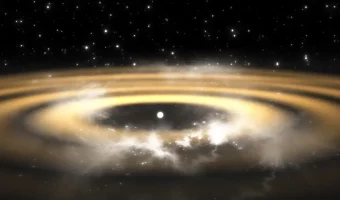
The Race Against Time: Understanding How Long it Takes for Light to Reach Earth
Last Updated: March 7, 2023
The speed of light is incredibly fast and considered unreachable by technology or anything other than light. And yet, even if we could travel at the speed of light, it would take many lifetimes, if at all, to reach many destinations. Let’s explore the speed of light and how we use it to study the universe, including how we look into the past in the night sky.
The speed of light
When someone turns on a light, how long does it take for someone else to see it? When the first ray of sunlight breaches the horizon, how long has it been since it was emitted from the Sun?
Greek philosophers argued whether light had a rate of travel (since it could indeed travel) or if it was simply instantaneous, but they didn’t have any way to prove either hypothesis. Galileo attempted to measure the speed of light in the mid-1600s by having two people stand on hills less than a mile apart with shielded lanterns. Person A would uncover their lantern and when Person B saw the flash, he uncovered his too. Less than a mile was not nearly far enough to measure an accurate speed, but, he did conclude that light traveled at least ten times faster than the speed of sound (343 m/s or 1,087 ft/sec).
In the 1670s, Danish astronomer Ole Rømer was studying the exact time of the eclipses of Jupiter’s moon Io to create an astronomical calendar for sailors, but noticed the eclipses didn’t follow his calculations. When Jupiter and Earth were moving away from each other, the eclipses lagged. When the planets were moving toward each other, the time eclipse arrived early. When they were at their closest or furthest distance, the eclipse arrived right on schedule. From this data, he was able to infer that light had a measurable rate at which it traveled. He was able to estimate the speed of light from his data at about 124,000 miles per second (200,000 km/s). Since scientists had not known the exact size of the solar system and the Earth’s orbit at that time, it was not correct, but it was the best estimate at the time and his findings changed astronomy.
Other scientists, began analyzing the speed of light using precisely aligned mirrors that reflected light over great distances to determine how long it took for light to travel that far. English physicist James Bradley, French physicist Hippolyte Fizeau, and French physicist Leon Foucault each measured more and more precisely, getting to within 1% and then about 1,000 miles per second (1,609 km/s) of the speed of light.
Albert A. Michelson dedicated himself to the speed of light and light in general, creating the new best estimate of 186,355 miles per second (299,910 km/s) in 1879 and then fine-tuning it not just once, but twice with his final experiment shortly before his death in 1931 resulting in just under today’s accepted value of the speed of light. He also proved that light did not operate as a wave (like sound) as was the prevailing theory because that would require a medium (generally referred to as a luminiferous aether or simply aether to travel through space) and he found no evidence of any such aether meaning light can and does travel through the vacuum of space, earning him a Nobel Prize.
With more precise instruments in better-controlled environments, we have been able to confirm that the speed of light is 299,792,458 meters (983,571,056 feet) per second which is 299,792 kilometers per second or about 186,282 miles per second. That’s fast enough to travel around the equator about 7.5 times in one second.
The speed of light is a universal constant known in equations as “c,” or light speed. The speed of light is constant because light acts as both a particle and a wave, meaning it does not need a medium to travel through. In fact, light’s speed from either a stationary object or a moving object is always the same.
Light traveling through a vacuum (or imperfect vacuum such as space) travels at the constant speed of light, but light that travels through a medium bends when it comes in contact with particles, slowing it down. The measure of how much a material slows down light is known as its refractive index. Earth’s atmosphere, for instance, slows down light by about three ten-thousandths of the speed of light whereas light traveling through a diamond slows down to less than half its original speed.
Astronomy/ astrophysics is essentially the only field of study where you can’t physically be in the room with what you are studying. The only way we can study it is by observing the light that reaches us. Understanding how light behaves and travels is crucial to being able to analyze that light and data. The speed of light helps us calculate distance, size, location, and more.
In addition, the speed of light is integral in understanding the conversion of mass into energy with Einstein’s famous equation E=mc2 which explains how tiny amounts of mass can turn into massive amounts of energy. However, for an object to reach the speed of light, its mass would have to become infinite, meaning the energy needed to move the object would also become infinite which is an impossibility. (However, we have observed that the universe is expanding faster than the speed of light, which is a paradox we still do not understand). Understanding these possibilities and limitations allows us to study the universe, and create more accurate algorithms and simulations to better understand how the universe works.

The distance to other celestial objects
If you hold out your thumb at arm’s length (ideally covering something in front of you, but not necessary), close one eye, and then switch which eye is open, you will see your thumb move slightly. This is a very simple, Earth-based example of parallax, when an object’s location is displaced based on point of view. By measuring this small displacement and the distance between your eyes, you can calculate the distance to your thumb using trigonometry to find the top of the cone that engulfs the space in between.
While it may look like a two-dimensional projection above our heads, we must remember that space is three-dimensional. Stars may seem like they are right next to each other, but in reality, not only are they far apart from each other, but one is likely closer than the other and it may be the one you don’t expect. In addition, we are on a planet orbiting the Sun, meaning our location in our orbit impacts how we see stars in the night sky. Every six months, the Earth moves about 186 million miles (300 million kilometers) to the other side of the Sun, displacing its view of the universe around it. This is a relatively small amount based on the size of the universe, but enough to cause stars to perform tiny circles throughout the year, so tiny that detecting and measuring them is difficult.
The ancient Greek astronomer Hipparchus was the first to use parallax to determine the location of a celestial object: the Moon. He had a solar eclipse observed from two separate locations to calculate how far away the moon was. Mars’ distance from Earth was determined using parallax in 1672 by Giovanni Cassini and his colleague Jean Richer during simultaneous observations in Paris and French Guiana. To measure the exact location of small objects in the sky, we break up the sky into degrees. From one horizon to the opposite is 180 degrees, half of a full circle which would go around the Earth. From one horizon to the point straight above your head (the zenith) is 90 degrees. Special tools on telescopes help to measure these degrees similar to a large protractor from your school days. You can also estimate using a closed fist held out at arm’s length being about 10 degrees. A degree is about the width of your pinky held at arm’s length. A degree is then broken into 60 arcminutes and each arc minute is broken into 60 arcseconds. Arcminutes and arcseconds definitely need special tools to measure accurately. Even the closest stars have a shift of less than an arcsecond when analyzing parallax.
Simultaneous observations from 2 locations on opposite sides of the world worked for objects within our solar system, but for objects outside of the solar system, like stars, we needed to factor in the orbit of Earth, taking measurements from opposite ends. Friedrich Bessel in 1838 then used the method to determine the distance from star 61 Cygni, in the Cygnus constellation, from Earth, springboarding the long process of creating a three-dimensional map of the night sky which took decades and improvements in the telescope to make the process easier.
Today, we also use parallax by comparing earth observations with observations from probes and missions out in the solar system such as New Horizons, providing even more distance to calculate even more specific measurements. Even using parallax and our updated technology, we eventually find that stars are too far away to calculate the minute changes. Instead, we build on the parallax method using stars that are known as “standard candles” for comparison in intrinsic brightness to determine distance. Using parallax and similar methods we can determine how far away a star is. A light-year is the distance light can travel in 1 year or about 6 trillion miles (10 trillion kilometers) and is the main measurement we use for calculating the distance to other stars. If we took the circumference of the Earth, laid it out on a straight line, and multiplied it by 7.5, we would get one light second. We would then need 31.6 million of those light-second lines to create the distance of a light-year.
Light from the sun takes about 8 minutes to reach Earth meaning our Sun is 8 light-minutes away from us. The closest stars to us are the Alpha Centauri triple-star system which is about 4.37 light-years away, meaning if we could travel at the speed of light (which again is impossible) it would take us just under 4 years and 4.5 months to travel the distance. The closest of these stars is Proxima Centauri which is about 4.24 lightyears away from us, meaning just under 4 years and three months at the speed of light. Remember that a light-year is about 6 trillion miles meaning they are over 26 trillion miles or 43.7 trillion km away. Voyager 1 would take over 73,000 years to arrive at Proxima Centauri.
Another important factor in this section before we move on is redshift. The frequency of light or sound emitted by a moving object changes based on if it is moving closer to the observer or farther away. Objects moving away from the observer shift towards “redder”, longer wavelengths, which is where we get the term redshift. If they are moving toward us, the frequencies shift to shorter, bluer frequencies. This is also known as the Doppler Effect, especially with sound waves, which you can hear as the change in tone when a siren passes by you. Understanding redshift helps us to better calculate the distances and locations of celestial objects, which are always moving. This was first discovered when Ole Rømer was studying the eclipses of Io and fundamentally changed our understanding of astronomy.

The time it takes for light to reach Earth
If we know how many lightyears away an object is, that is also how many years it would take for light from that star to reach us (and vice versa). When we are looking at stars, we are looking back in time, seeing them as they were when their light left, whether that is dozens, hundreds, millions, or hundreds of millions of years ago. Let’s explore a few famous stars to better understand their light.
The brightest star in the night sky is Sirius A in Canis Major, the Big Dog Constellation and it is 8.6 light-years away. The light we see from it is almost nine years old.
Looking at the Big Dipper in Ursa Major, most of the stars, excluding the far end of the handle and the top right of the dipper, are about 80-83 light-years away. Alkhaid and Dubhe (the two exceptions mentioned previously) sit at 104 and 123 light-years away respectively. On average, the light from the stars in the Big Dipper took about a century to reach us and we look at it as it was a hundred years ago.
But this is abnormal. Many stars within a constellation are not close by at all in reality. If we look at the Northern Cross of the Cygnus/ Swan constellation, Epsilon (ε) Cygni in the eastern end of the crossbeam is located 73 light-years from Earth, and is almost 36 times closer than Deneb, or Alpha (α) Cygni, at the head of the cross.
Betelgeuse, the bright red star in the armpit of Orion is 642.5 light-years away meaning the light we see from Betelgeuse is almost 650 years old. If there was intelligent life near Betelgeuse looking at us, they would see us as we were in the 1300s!
Some of the most distant stars in the Milky Way are known as RR Lyrae stars in the halo surrounding our galaxy over a million light-years away. The furthest stars are almost halfway to Andromeda, our sister galaxy, which is about 2.5 million light-years away. Finally, in 2022, Hubble spotted Earendel, the most distant star detected 28 billion light-years away.
When considering how bright a star is, we have to consider both how much light it is putting out and how far away it is (in addition to other factors such as what’s between us and them like clouds of gas and dust).
Apparent magnitude is how bright we see the star from Earth while absolute magnitude is how bright the star is at a standard distance of 32.6 light-years (equal to 10 parsecs, the next rung up on the distance measurements of the universe). To understand its actual luminosity or brightness, astronomers look at its color spectrum, what it’s emitting on the electromagnetic spectrum in the visible light range which correlates to temperature and therefore brightness.
Knowing the difference between the apparent magnitude and the absolute magnitude or actual brightness/ luminosity helps astronomers calculate the distance to the star. The magnitude scale was determined by Ptolemy in the 2nd century C.E. with the brightest stars receiving a magnitude of 1 and the dimmest receiving a magnitude of 6 with a 100x difference in brightness in between, but has expanded as our instruments can spot dimmer objects.
Brighter stars produce more light, but the farther away a star is, the dimmer it will appear. A brighter star might be further away if it is producing more light than a closer star. For instance, the brightest star in the night sky is Sirius A at 8.6 light-years away and about -1.33 magnitude, but the closest star to us is Proxima Centauri at 3.24 light-years away but much dimmer at a magnitude of 11. For more about brightness and magnitude see our previous article on the brightest planets.

How long it takes for light from each planet in our solar system to reach Earth
Here are the average distances of each planet in our solar system from Earth, and the corresponding amount of time it takes for light to travel from that planet to Earth:
- Mercury: 77 million km (48 million miles) away from Earth on average so it takes about 3.2 minutes for light from Mercury to reach Earth.
- Venus: 261 million km (162 million miles) away from Earth on average so it takes about 6 minutes for light from Venus to reach Earth.
- Mars: 78 million km (48 million miles) away from Earth on average so it takes about 3-22 minutes (depending on the positions of Mars and Earth in their respective orbits) for light from Mars to reach Earth.
- Jupiter: 628 million km (390 million miles) away from Earth on average so it takes about 35-52 minutes (depending on the positions of Jupiter and Earth in their respective orbits) for light from Jupiter to reach Earth.
- Saturn: 1.28 billion km (795 million miles) away from Earth on average so it takes about 1-2 hours for light from Saturn to reach Earth.
- Uranus: 2.72 billion km (1.7 billion miles) away from Earth on average so it takes about 2.5-3 hours for light from Uranus to reach Earth.
- Neptune: 4.35 billion km (2.7 billion miles) away from Earth on average so it takes about 4-4.5 hours for light from Neptune to reach Earth.
So, the time it takes for light from each planet in our solar system to reach Earth varies depending on the distance between the two.
Conclusion
Astronomy is the study of light from the night sky because, in general, that’s the only way we can study these specimens. Understanding how light works is vital to understanding the data we observe.
Understanding the speed of light (299,792 kilometers per second or about 186,282 miles per second) and the fact that it is constant even if the source is moving helps us to understand the dynamics of our universe as well as the impact of this speed on mass and energy. The speed of light is effectively a speed limit for objects in the universe as the mass and energy would need to be infinite to surpass it which is impossible.
We also use the speed of light to calculate the distance to celestial objects using light-years, the distance light travels within a year, and better understand the apparent brightness we see on Earth compared with the actual brightness emitted from a star.
Understanding light helps us understand the universe because it helps us quantify what we see and therefore understand the mechanics of the universe.

Sarah Hoffschwelle is a freelance writer who covers a combination of topics including astronomy, general science and STEM, self-development, art, and societal commentary. In the past, Sarah worked in educational nonprofits providing free-choice learning experiences for audiences ages 2-99. As a lifelong space nerd, she loves sharing the universe with others through her words. She currently writes on Medium at https://medium.com/@sarah-marie and authors self-help and children’s books.
Wow! There's more to read 🚀
This page is part of our collection of articles about astronomy. If you enjoyed the read, then you’ll love the following articles.




